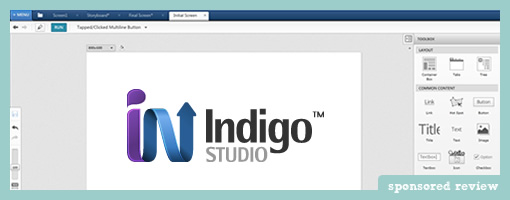Indigo Studio
January 9th, 2013
Indigo Studio, a new interaction design tool, has been released just over a month ago by the Infragistics team on both MAC and Windows. The first version is completely free and there is no catch (future versions 2 and on will be paid). It has some interesting aspects to it:
Storyboarding
The tool itself is interesting in that it has two modes of working: screen and storyboard. The screen mode allows designers to express the position and layout of typical interface elements in a traditional sense – pretty standard for a modern UI prototyping tool. Storyboarding mode however allows designers to work at a higher level of abstraction and see the bigger picture with multiple screens in view. Here the designer is given the opportunity to think bigger than just screens as the links between them come into view. Additionally, stepping beyond just screens, Indigo Studio comes preloaded with helpful sketched out real world “scenes” of people using various devices in various context. This sets the tone to think beyond just the UI.
Interactions
Once elements are laid out, Indigo Studio allows designers to express a set of interactions or events that tie screens together into a clickable prototype. Interactions can be attached to various elements or plain hotspots (helpful if you simply wish to upload JPGs or sketches from another application). Typical interactions include such things as when a user: focuses, double clicks, focuses, changes a field, or right clicks.
Screen States & Transitions
Screens in Indigo Studio have been elaborated to include multiple states that offer a helpful way to reuse elements across a more complex situation. For example, placing an element (or making changes to it) on the first state of a screen will automatically duplicate the element (or changes) across all of its states. Of course secondary states can also be modified to incorporate unique changes as a result of interactions. All screens and screen states can also be tied with handy transitions whose delays and durations can be defined as well.
Sharing and Feedback
Additionally, all prototypes in Indigo Studio can also be shared online for further comments and feedback. Sharing a prototype generates a useful link which can be sent to the team.
Indigo Studio looks pretty solid for a first release and I’m curious what future versions might bring. Ready to see if it works for you? Give it a try.























